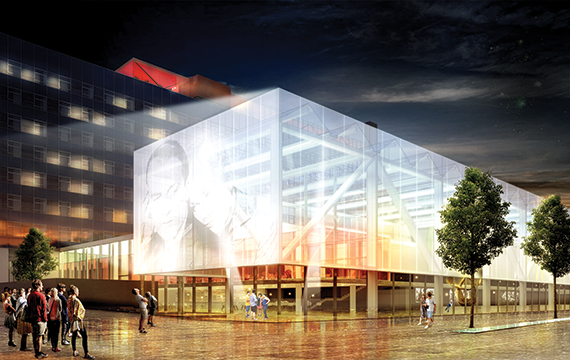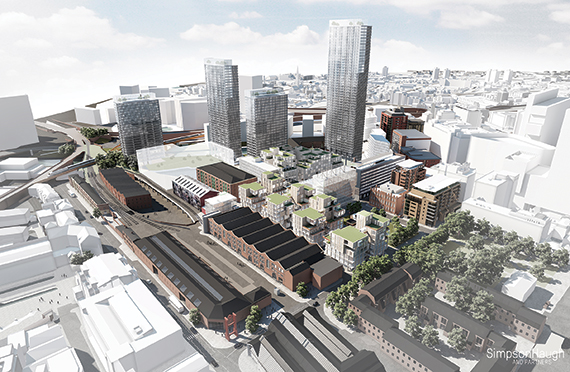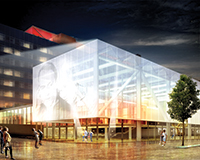 Fifteen years after Manchester’s first city-centre home sold for £1m, Allied London is building St John’s, a neighbourhood of 1,380 studios, penthouse apartments and family homes in a bid to bring the affluent classes back to the city.
Fifteen years after Manchester’s first city-centre home sold for £1m, Allied London is building St John’s, a neighbourhood of 1,380 studios, penthouse apartments and family homes in a bid to bring the affluent classes back to the city.
It will be Allied London’s first residential-led development, and Manchester’s first inner-city neighbourhood developed from scratch.
Having purchased the 15-acre former ITV estate in partnership with Manchester City Council for £26.5m in 2013, the developer has now created a £1.5bn masterplan with architect SimpsonHaugh and Partners.
In addition to housing, the neighbourhood will include about 500,000 sq ft of workspace and 200,000 sq ft of retail and leisure in a series of skyscrapers providing an elevated retreat above a village of five-to-seven-storey buildings overlooking the river Irwell.
Traditionally, affluent professionals have moved to larger homes in Cheshire and commuted into the city. So is there a market for prime city-centre resi?
“Top-of-the-range Manchester is not Belgravia,” says Allied London’s development director Greg Attwood, when asked who he thinks would want to live in the neighbourhood.
“But I think it could be anything from a young professional couple – maybe they’ve got a young kid – to a professional services partner’s pied à terre.”
Conscious choice
He says residents will be “making a conscious choice” to live in the city when they could buy a big four-bedroom house in Hale or Bowdon for the same price.
It is part of Allied London chief executive Mike Ingall’s ambition that St John’s will tap into a growing trend for urban living. “People want to cluster; they want things to be in an urban environment; they like things on their doorstep,” he says.
“The whole country’s demographics have changed, haven’t they? We’ve got a lot more single people, we’ve got a lot more single people with children; people are living a lot longer; people want to enjoy an urban way of life.”
Government data shows Manchester had a population of just 520,215 in mid-2014 – compared with London’s 8.6m.
 There have been attempts to encourage city-centre living in Manchester, and other northern cities, before. But previously the target buyers or renters were “Dinks” – dual income, no kids.
There have been attempts to encourage city-centre living in Manchester, and other northern cities, before. But previously the target buyers or renters were “Dinks” – dual income, no kids.
At St John’s, Allied is targeting a much broader range of residents, everyone from young professionals to multi-generational families, with one-bed flats for rent to four-bed family flats with spacious roof gardens to buy.
The developer has yet to reveal prices, but Ingall says: “This is not affordable housing, this is not social housing. One thing Manchester is not short of is social housing, affordable housing.”
JLL predicts a 26.4% increase in Manchester house prices in the next five years, with 5.5% growth during 2016. A prime two-bed city-centre flat with an average price of £265,000 could now leap to £279,000 by the end of the year.
Savills residential development director Rob Sumner says St John’s will help to fill a gap in the undersupplied prime residential market.
“There was a scheme at 8 King Street that was 20 units and achieved unprecedented levels of value per sq ft at the time of release [£400 per sq ft]. And it sold in the blink of an eye, which gives you a good idea that the prime market has not been well served,” he says.
“It isn’t and it hasn’t been, but the flip side of that is the market in Manchester means developers need to make sure that schemes adhere to the everyman strategy to achieve that absorption rate in Manchester.”
No doubt there will be keen interest to see what sort of appetite there is for premium residential space when the first phase, South Village, is soft launched in April.
At the centre of the developer’s vision is a new breed of affluent creative classes, who Ingall feels will be drawn to the city’s industrial heritage and cheaper cost of living compared to London.
“We’re living in an era which is the rise of the creative classes, and that’s definitely a sort of reaction to what happened in 2008,” he says.
While he acknowledges Manchester is not currently recognised as a hub for the creative classes, the right development will change that (see below).
Is the Manchester market ready for pied-à-terres and penthouse apartments? Ingall says it all fits within another story he supports: the northern powerhouse. “I think that’s a great story…We can buy into it, other people can buy into it,” he says.
Part of that story involves attracting overseas investors, from places such as the Far East and Middle East, from where Attwood believes “there will be demand from large-volume buy-to-let investors”.
“These were all industrial cities that have been famous and wealthy and prosperous before,” says Ingall. “And when you’ve got that, there’s no reason they can’t be wealthy and famous and prosperous again.”
The Factory
The cultural anchor of the neighbourhood will be the The Factory, a £110m arts centre part-funded by government (£78m) which Allied London says will be “like no other arts venue, performance centre of its type of the world”.
Due to open in 2019, it will be the new home of Manchester’s biennial International Festival, which has been running since 2007, and will include a 1,800-seat theatre and large, flexible studio space.
Commercial space to drive residential values
St John’s will included 500,000 sq ft of workspace and 200,000 sq ft of retail and leisure, with the emphasis primarily on attracting occupiers that fit in with the ethos of creative living.
Allied London’s neighbouring development, Spinningfields, showed how charging lower rents to draw interesting food and beverage outlets helps to attract office occupiers.
At St John’s, Allied chief executive Mike Ingall hopes a subsidised leisure offering will not only attract interesting occupiers, but will also drive up residential values.
“It’s circular,” he says. “We can’t afford not to attract the creatives to the workspace, because we need them to make the neighbourhood. We’re not going on a big retail leasing campaign to talk to Zara and Reiss and Next. We want people who make things.”
Development director Greg Attwood adds: “That’s not going to get us the highest rent on a shop unit, but it’s going to make it a much more interesting place to live in the apartments above.
“So it’s really about driving value in apartments rather than how much money can we make out of shops.”
One idea is to put workshop space in the lower levels of the 125,000 sq ft Bonded Warehouse, which could open to the public as artists’ and designers’ showrooms at weekends. The upper levels will provide flexible workspace aimed at the ` and creative sectors.
“We’re going to basically create a neighbourhood of enterprise with St John’s which will complement the living space,” says Ingall. “And enterprise is anything from opening a café to opening an online boutique, to attracting the world’s largest social media company.”











